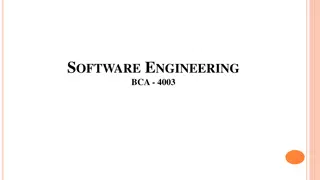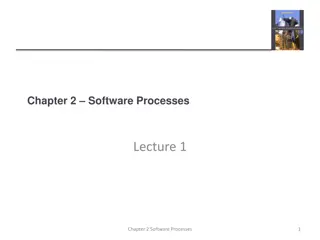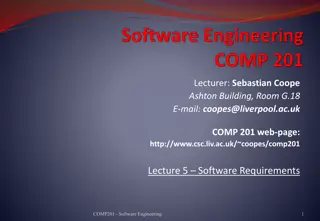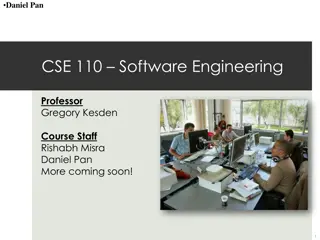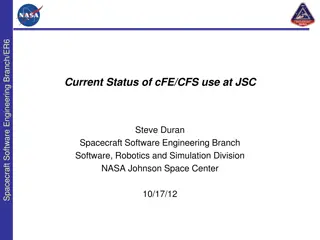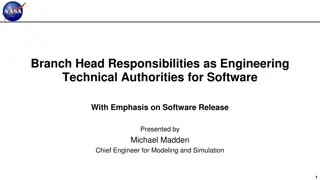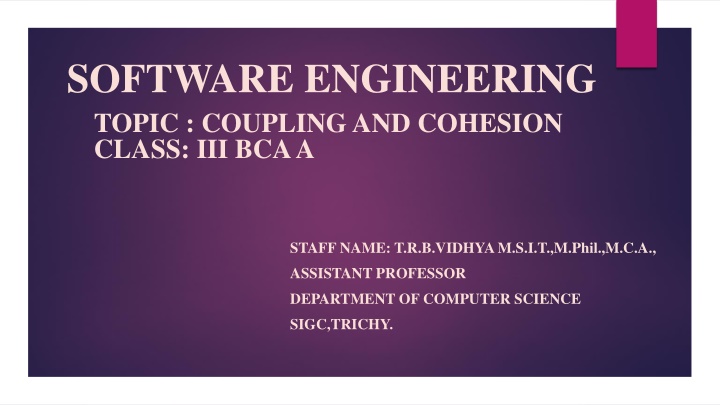
Coupling and Cohesion in Software Engineering
Software engineering involves the development of computer programs with a focus on software production aspects. The software development life cycle model consists of stages like planning, requirement analysis, design, coding, testing, and maintenance. Coupling and cohesion are crucial concepts in software engineering, with coupling determining the interdependence between modules and cohesion indicating the degree of relatedness within a module. Different types of coupling include data coupling and stamp coupling, each affecting the efficiency and maintainability of software systems.
Download Presentation

Please find below an Image/Link to download the presentation.
The content on the website is provided AS IS for your information and personal use only. It may not be sold, licensed, or shared on other websites without obtaining consent from the author. If you encounter any issues during the download, it is possible that the publisher has removed the file from their server.
You are allowed to download the files provided on this website for personal or commercial use, subject to the condition that they are used lawfully. All files are the property of their respective owners.
The content on the website is provided AS IS for your information and personal use only. It may not be sold, licensed, or shared on other websites without obtaining consent from the author.
E N D
Presentation Transcript
SOFTWARE ENGINEERING TOPIC : COUPLING AND COHESION CLASS: III BCA A STAFF NAME: T.R.B.VIDHYA M.S.I.T.,M.Phil.,M.C.A., ASSISTANT PROFESSOR DEPARTMENT OF COMPUTER SCIENCE SIGC,TRICHY.
INTRODUCTION SOFTWARE: Computer programs, procedures and possibly associated documentation and data pertaining to the operation of a computer system. SOFTWARE ENGINEERING: It is concerned with all aspects of software production.
SOFTWARE DEVELOPMENT LIFE CYCLE MODEL A series of identifiable stages that a software product undergoes during its lifetime. 1) Planning. 2) Requirement analysis and specification. 3) Design. 4) Coding. 5) Testing. 6) Maintenance.
INTRODUCTION The purpose of Design phase in the Software Development Life Cycle is to produce a solution to a problem given in the SRS (Software Requirement Specification) document. The output of the design phase is Software Design Document (SDD). Basically, design is a two-part iterative process. First part is Conceptual Design that tells the customer what the system will do. Second is Technical Design that allows the system builders to understand the actual hardware and software needed to solve customer s problem.
COUPLING In software engineering, Coupling is the measure of the degree of interdependence between the modules. A measure of how closely connected two routines or modules. A good software will have low coupling.
DATA COUPLING To communicate by passing only data, then the modules are said to be data coupled. This is an best form of coupling. Example-customer billing system.
STAMP COUPLING In stamp coupling, the complete data structure is passed from one module to another module.
CONTROL COUPLING If the modules communicate by passing control information, then they are said to be control coupled.
COMMON COUPLING Common coupling (also known as Global coupling) occurs when two modules share the same global data (e.g., a global variable). Changing the shared resource might imply changing all the modules using it.
CONTENT COUPLING In a content coupling, one module can modify the data of another module or control flow is passed from one module to the other module. This is the worst form of coupling and should be avoided.
COHESION Cohesionis a measure of the degree to which the elements of the module are functionally related. It is the degree to which all elements directed towards performing a single task are contained in the component. A good software design will have high cohesion. Cohesion is an ordinal type of measurement and is usually described as high cohesion or lowcohesion .
TYPES OF COHESION Functional Cohesion. Sequential Cohesion. Communication Cohesion. Procedural Cohesion. Temporal Cohesion. Logical Cohesion. Coincidental Cohesion.
FUNCTIONAL COHESION Every essential element for a single computation is contained in the component. A functional cohesion performs the task and functions. It is an ideal situation.
SEQUENTIAL COHESION An element outputs some data that becomes the input for other element. i.e., data flow between the parts. It occurs naturally in functional programming languages.
COMMUNICATION COHESION Two elements operate on the same input data or contribute towards the same output data. Example- update record in the database and send it to the printer.
PROCEDURAL COHESION Elements of procedural cohesion ensure the order of execution. Actions are still weakly connected and unlikely to be reusable. Example - calculate student GPA, print student record, calculate cumulative GPA, print cumulative GPA.
TEMPORAL COHESION The elements are related by their timing involved. A module connected with temporal cohesion all the tasks must be executed in the same time-span. This cohesion contains the code for initializing all the parts of the system. Lots of different activities occur, all at unit time.
LOGICAL COHESION The elements are logically related and not functionally. Ex- A component reads inputs from tape, disk, and network. All the code for these functions is in the same component. Operations are related, but the functions are significantly different.
COINCIDENTAL COHESION The elements are not related(unrelated). The elements have no conceptual relationship other than location in source code. It is accidental and the worst form of cohesion. Ex- print next line and reverse the characters of a string in a single component.
REAL TIME APPLICATION IN COHESION Cohesion is a leading Intelligent Buildings software solution that is disrupting how buildings operate and how people engage with buildings from real estate owners, operators, building engineers, to tenants and visitors. Drawing from a real-life example: there would be a thousand things in your home. But if asked to fetch your tennis racket, you can get it in a matter of minutes, if not seconds. If you are asked to get a cooking utensil, you immediate go the kitchen. How is it that you are able to retreive things quickly? Because you have organized them in a highly cohesive way. You have put all the related things together. That is cohesion at play in real life.

